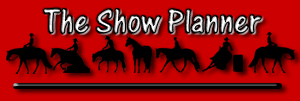 |
|
Show Horse Promotions Mary Murray
|
Hauling HorsesThere are many things that you should think about before hauling horses. Safety is the most important factor. To achieve this, here are some things that should be considered:
There are many different types of trailers, most have many good aspects and many have things things that need design changes. The most important thing here is which type of trailer will be less stressful on the horse. Many feel that with the slant type horses seem to ride more easily, more stable on starts and stops and less trailering stress. Horses also like to see what is happening as well as other horses. The traditional stock type trailers are still an effective and safe way to transport horses. Horses can be tied head to tail, head to head, and even on the slant sides of the trailer. The key to avoid injuries to the horse is to limit the number of horses on the trailer and not to over crowd. A rule of thumb is to provide a trailer that is 10 inches taller than the normal resting position of the head of the horse. The trailer width should provide enough space to permit 3 inches of lateral movement on each side of the horse. A trailer that provides a 30-inch width may be fine for an Arabian, but might be much to narrow for a heavy muscled quarter Horse. Here are some other features of a trailer that should be considered:
It is recommended that horses are tied with a quick release knot or easy release snaps permanently fixed tie lines in the trailer. A head bumper should be used for those horses that fight the trailer (can help prevent injury to the head) and tail wraps to protect horses that ride the butt bar. Leg Wraps should be used and extend from the hock downward, including the coronary band. Horses that paw or kick the trailer or climb the sides may need knee & hock pads. If traveling for more than 18 hours, horses should be unloaded, exercised and allowed time to eat & drink. (Use extreme caution unloading in unknown areas). When traveling long distances, water should be watered every 3-4 hours. Maintaining water consumption may prevent impaction and colic. Additives such as lemonade or sports drink can be used to mask any changes in water before and during the trip. Limiting or not feeding grain while feeding free choice hay to horses in transit can make for a good trailering experience. If using a hay net, make sure the net is tied high and tight to prevent getting caught up in feet and legs. The last thing to remind you of is one of the most important. When traveling with your horse, make sure you are aware of the health requirements for interstate and out of state trips. Proof of Coggins with current health certificate is pretty universal. To find out the different state requirements call 1-800-545-8732 or go to
http://www.aphis.usda.gov/vs/sregs/ Article supplied by Ben Chase; NC Cooperative Extension Service |
||||||||||||||||||||||||||
|
© 2000 - 2010 Show Horse Promotions The Show Horse Promotions web site is an informational web site, this information is subject to change without notice. Any use of, or actions taken based upon any of the information contained on this web site is done entirely at your own risk. Show Horse Promotions expressly prohibit you from republishing or redistributing this content without first receiving our written consent. By using this site, you agree not to hold us liable for any errors or delays in this content, or for any actions that you take in reliance thereon. This site contains links to other Internet sites. These links are not endorsements by us of any products or services in those sites, and we have not endorsed or approved any information in those sites. |
|
||||||||
